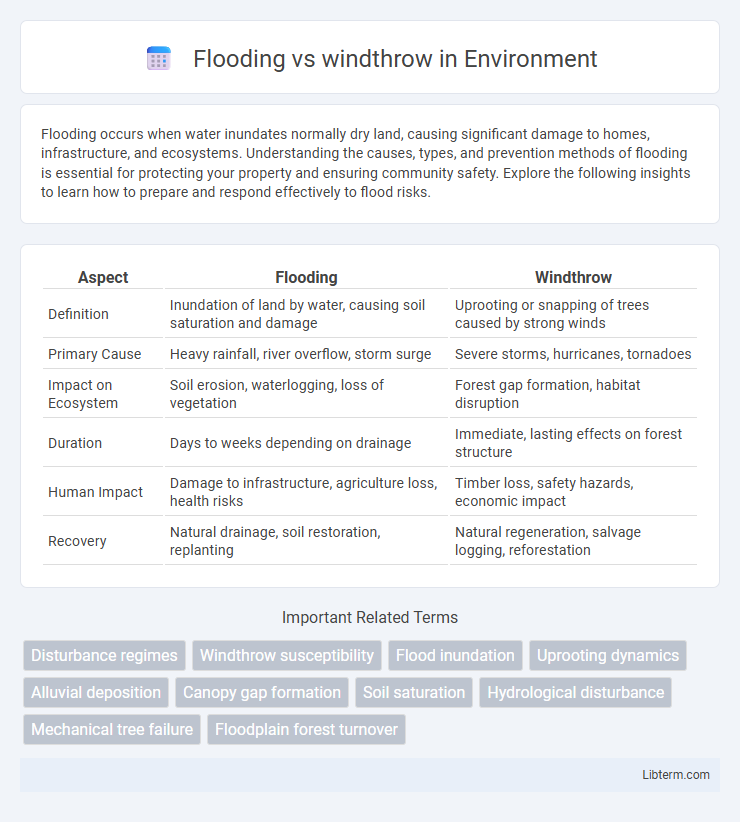Flooding occurs when water inundates normally dry land, causing significant damage to homes, infrastructure, and ecosystems. Understanding the causes, types, and prevention methods of flooding is essential for protecting your property and ensuring community safety. Explore the following insights to learn how to prepare and respond effectively to flood risks.
Table of Comparison
| Aspect | Flooding | Windthrow |
|---|---|---|
| Definition | Inundation of land by water, causing soil saturation and damage | Uprooting or snapping of trees caused by strong winds |
| Primary Cause | Heavy rainfall, river overflow, storm surge | Severe storms, hurricanes, tornadoes |
| Impact on Ecosystem | Soil erosion, waterlogging, loss of vegetation | Forest gap formation, habitat disruption |
| Duration | Days to weeks depending on drainage | Immediate, lasting effects on forest structure |
| Human Impact | Damage to infrastructure, agriculture loss, health risks | Timber loss, safety hazards, economic impact |
| Recovery | Natural drainage, soil restoration, replanting | Natural regeneration, salvage logging, reforestation |
Understanding Flooding and Windthrow: Key Differences
Flooding involves excess water submerging land, causing soil saturation that weakens root stability, while windthrow refers to trees being uprooted or broken by strong winds, directly impacting forest structure. Flooding leads to oxygen deprivation in roots, often resulting in tree stress or mortality, whereas windthrow causes immediate physical damage and changes in forest canopy dynamics. Understanding these distinct disturbances is crucial for effective forest management and resilience planning.
Causes of Flooding and Windthrow Events
Flooding occurs primarily due to excessive rainfall, river overflow, storm surges, or rapid snowmelt, leading to water inundation in low-lying areas. Windthrow events happen when strong winds or storms uproot or snap trees, commonly triggered by hurricanes, tornadoes, or severe thunderstorms. Soil saturation from prolonged rainfall can weaken tree roots, increasing susceptibility to windthrow during high wind conditions.
Environmental Impact: Flooding vs. Windthrow
Flooding causes extensive soil erosion and nutrient depletion, disrupting aquatic ecosystems and leading to habitat loss for many plant and animal species. Windthrow results in the uprooting or snapping of trees, creating gaps in forest canopies that alter microclimates and affect biodiversity. Both events significantly reshape ecological landscapes but differ in their mechanisms and long-term effects on soil structure and vegetation recovery.
Effects on Ecosystems and Biodiversity
Flooding can drastically alter ecosystems by submerging vegetation, reducing oxygen availability, and causing nutrient depletion, which leads to significant losses in plant and animal biodiversity. Windthrow results in uprooted trees and canopy gaps, creating microhabitats that increase species diversity but also disrupt forest structure and succession. Both phenomena impact ecosystem functions, but flooding typically causes more immediate mortality, while windthrow influences long-term habitat heterogeneity.
Human and Economic Consequences
Flooding causes significant human displacement, property damage, and infrastructure collapse, leading to high economic costs in emergency response and long-term rehabilitation. Windthrow results in large-scale forest damage, impacting timber industries and causing economic losses through decreased wood supply and increased clearing expenses. Both events disrupt livelihoods, but flooding often entails more immediate health risks and broader community-wide economic destabilization.
Vulnerable Geographic Regions
Coastal floodplains and river basins are highly vulnerable to flooding due to low elevation and poor drainage, while mountainous and heavily forested regions face significant risk from windthrow events caused by strong storms and saturated soils. Areas such as the Gulf Coast, Mississippi Delta, and parts of Southeast Asia experience frequent flooding, whereas the Pacific Northwest, Scandinavia, and Central Europe are prone to extensive windthrow damage during intense cyclonic weather. Understanding the geographic and climatic factors influencing these natural hazards is crucial for targeted mitigation and resilience planning in vulnerable regions.
Prevention and Mitigation Strategies
Flooding prevention strategies involve constructing levees, improving drainage systems, and implementing rainwater harvesting to manage excess water and reduce soil erosion. Windthrow mitigation focuses on maintaining forest health through selective thinning, planting wind-resistant tree species, and designing buffer zones to stabilize root systems and minimize uprooting. Both hazards benefit from early warning systems and landscape planning to enhance ecosystem resilience and reduce damage.
Role of Climate Change in Flooding and Windthrow
Climate change intensifies flooding by increasing the frequency and severity of extreme rainfall events and storm surges, causing prolonged soil saturation and river overflow, which destabilizes tree root systems. Warmer temperatures and changing precipitation patterns also amplify windthrow by altering forest structure and increasing the vulnerability of trees to strong winds during storms. These climate-induced stressors synergistically elevate the risk of ecosystem damage and disrupt forest regeneration cycles.
Case Studies: Major Flooding and Windthrow Incidents
The 2019 Midwest floods caused extensive crop damage and infrastructure loss, highlighting the devastating impact of prolonged inundation on agricultural and urban areas. In contrast, the 2018 Camp Fire in California illustrated windthrow dynamics as severe winds uprooted thousands of trees, exacerbating wildfire spread and forest destruction. Both case studies emphasize the need for integrated disaster management strategies tailored to specific hazard characteristics and regional vulnerabilities.
Future Outlook: Adapting to Natural Disturbances
Future outlooks for managing natural disturbances emphasize adaptive strategies to mitigate flooding and windthrow impacts on forest ecosystems. Enhanced predictive modeling and real-time monitoring support proactive interventions, promoting resilient forest management practices that accommodate increasingly frequent extreme weather events. Integrating ecological restoration with climate adaptation fosters long-term sustainability and ecosystem stability amid evolving disturbance patterns.
Flooding Infographic

 libterm.com
libterm.com